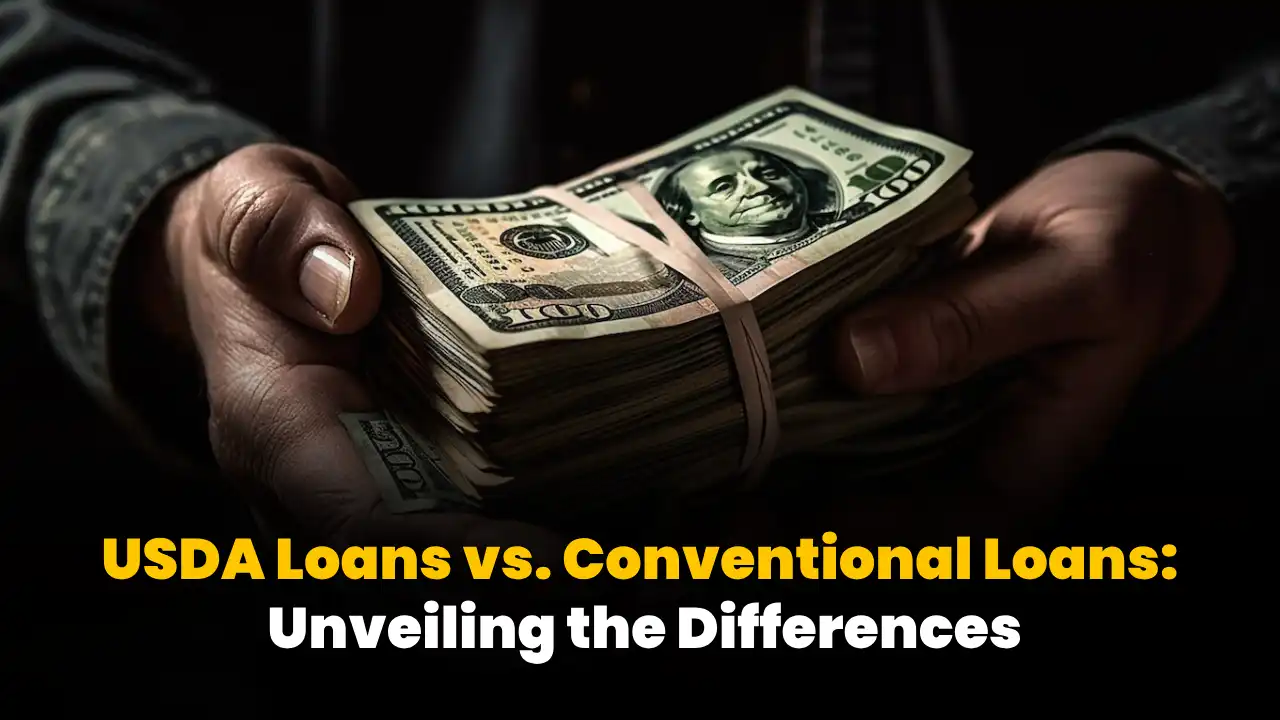Introduction
When it comes to financing a home purchase, prospective buyers have an array of options to choose from. Among the numerous choices available, two prominent ones are USDA loans and conventional loans. Each loan type caters to different sets of circumstances and financial profiles. In this article, we will delve into the distinctions between USDA loans and conventional loans, helping potential homebuyers make informed decisions based on their specific needs.
USDA Loans: Exploring the Basics
USDA loans, backed by the United States Department of Agriculture (USDA), are designed to assist individuals in rural and suburban areas with lower incomes in purchasing homes. The primary objective of USDA loans is to stimulate homeownership in areas that might not be as attractive to traditional lenders due to perceived higher risks. These loans offer several noteworthy features:
Zero Down Payment: One of the most distinctive advantages of USDA loans is the absence of a down payment requirement. This feature makes homeownership accessible to individuals who might not have substantial savings for a down payment.
Low Interest Rates: USDA loans often come with competitive interest rates, making them an attractive option for eligible borrowers.
Income Eligibility: USDA loans are tailored for low- to moderate-income households. The specific income limits vary based on location and family size.
Geographical Restrictions: These loans are exclusively available for properties located in eligible rural and suburban areas as designated by the USDA. This restriction ensures that the loans target the intended demographic.
Read More: https://www.benzinga.com/money/usda-loan-vs-conventional-mortgage
Conventional Loans: Understanding the Norm
Conventional loans are standard mortgage products offered by private lenders without government backing. They are the traditional go-to for homebuyers who meet certain credit and financial requirements. Conventional loans come with their own set of characteristics:
Down Payment Flexibility: Conventional loans typically require a down payment, with 20% being the traditional benchmark. However, down payments as low as 3% are now common, making conventional loans more accessible to a broader range of buyers.
Credit Score Requirements: While credit score requirements vary among lenders, conventional loans generally require a higher credit score compared to USDA loans.
Private Mortgage Insurance (PMI): If the down payment is less than 20%, conventional loan borrowers usually need to pay for PMI, which protects the lender in case of default. This is an additional cost that borrowers need to factor into their monthly payments.
Geographical Freedom: Unlike USDA loans, conventional loans do not have geographical restrictions. Borrowers can use them to finance properties in urban, suburban, or rural areas.
Choosing the Right Loan: Factors to Consider
The decision between a USDA loan and a conventional loan hinges on various factors that potential homebuyers should evaluate:
Location: If the property is in a designated rural or suburban area, a USDA loan might be more suitable due to its zero down payment feature.
Income: USDA loans cater to lower-income households, while conventional loans are available to a broader range of income levels.
Credit Score: Borrowers with a strong credit history might find conventional loans more favorable, whereas those with lower credit scores could consider USDA loans.
Down Payment: The amount of available funds for a down payment will influence the choice between the two loan types.
Requirements for USDA and conventional loans?
USDA Loan Requirements
Location Eligibility: USDA loans are intended for properties located in designated rural and suburban areas. The property’s location must meet the USDA’s criteria to be eligible for this type of loan.
Income Limits: Applicants must meet specific income limits based on their location and family size. USDA loans are designed to assist low- to moderate-income households in achieving homeownership.
Occupancy Requirement: Borrowers are required to use the property as their primary residence. USDA loans cannot be used for investment properties or second homes.
Credit History: While USDA loans generally have more lenient credit score requirements compared to conventional loans, a reasonable credit history is still necessary to demonstrate the borrower’s ability to manage debt.
Debt-to-Income Ratio: Lenders typically look for a manageable debt-to-income ratio. A lower ratio indicates that the borrower’s income is sufficient to cover existing debts and the proposed mortgage payment.
Home Appraisal: Like conventional loans, USDA loans require a home appraisal to determine the property’s value and ensure it meets the necessary safety and habitability standards.
Documentation: Applicants need to provide documents such as proof of income, tax returns, employment history, and other relevant financial records to establish their eligibility.
Read More: How To Obtain A Personal Loan From Wells Fargo
Conventional Loan Requirements
Credit Score: Conventional loans often require a higher credit score compared to USDA loans. Lenders generally look for a solid credit history to assess the borrower’s ability to manage credit responsibly.
Down Payment: While conventional loans traditionally demanded a 20% down payment, newer options allow for down payments as low as 3%. The required down payment amount can influence interest rates and whether private mortgage insurance (PMI) is required.
Debt-to-Income Ratio: Similar to USDA loans, lenders assess the borrower’s debt-to-income ratio to ensure they have the financial capacity to manage mortgage payments along with existing debts.
Private Mortgage Insurance (PMI): If the down payment is less than 20%, conventional loan borrowers are usually required to pay for PMI. PMI safeguards the lender in case the borrower defaults on the loan.
Income Verification: Lenders require documentation of stable and sufficient income to ensure that the borrower can afford the mortgage payments.
Property Appraisal: A professional appraisal is conducted to determine the property’s value and ascertain that it meets safety and livability standards.
Documentation: Borrowers need to provide a comprehensive set of documents, including income verification, tax returns, employment history, and other financial records, to demonstrate their creditworthiness.
USDA Loans vs. Conventional Loans: A Quick Comparison
USDA Loans and conventional loans are two distinct paths to homeownership, each with its own set of features and considerations. Here’s a concise comparison to help you understand their differences:
USDA Loans
- Location Focus: Designed for rural and suburban areas.
- Income Requirement: Tailored for lower-income households.
- Down Payment: No down payment required.
- Credit Score: More lenient credit score requirements.
- Private Mortgage Insurance (PMI): No PMI required, but there are upfront and annual fees.
- Property Appraisal: Mandatory for assessing property value and compliance.
Conventional Loans
- Location Flexibility: Available for urban, suburban, and rural properties.
- Income Range: No specific income limits.
- Down Payment: Down payments vary, with options as low as 3%.
- Credit Score: Typically requires a higher credit score.
- Private Mortgage Insurance (PMI): Required for down payments below 20%.
- Property Appraisal: Necessary to determine property value and condition.
The choice between USDA and conventional loans depends on factors like location, income, credit, and down payment capability. Understanding these distinctions will help you make an informed decision based on your unique situation and homeownership goals.
FAQ’s
What is better a USDA loan or a conventional loan?
The better option, USDA or conventional loan, depends on factors like location, income, credit, and down payment capacity. Choose based on your circumstances and goals.
Is a USDA loan good or bad?
A USDA loan’s goodness or suitability depends on your circumstances. It’s beneficial for lower-income buyers in designated areas, but assess based on your needs and financial situation.
What is the advantage of a USDA loan?
The key advantage of a USDA loan is the option for a zero down payment, making homeownership more accessible for eligible low- to moderate-income buyers in rural and suburban areas.
Conclusion
In the realm of home financing, the choice between USDA loans and conventional loans depends on individual circumstances. USDA loans are tailored for those with lower incomes and properties in rural or suburban areas, while conventional loans provide greater flexibility in terms of location and credit requirements. Assessing factors such as income, credit score, and down payment capabilities will aid potential homebuyers in making the optimal decision for their homeownership journey. It’s advisable to consult with mortgage professionals to gain personalized insights and make an informed choice that aligns with long-term financial goals.
Read More: VA Non-Allowable Fees: What Buyers Are Not Obligated To Pay







